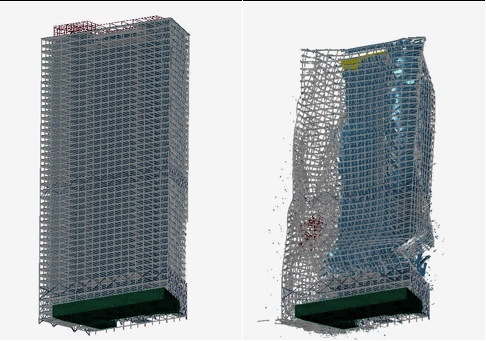
Goddard Space Flight Center, Greenbelt, Maryland 20771
ENGINEERING COLLOQUIUM
Monday, November 29, 2010 / 3:30 PM, Building 3 Auditorium
William Pitts
"Use of Visual Analysis for the World Trade Center Investigation"
ABSTRACT -- The attack on the World Trade Center (WTC) in New York City on September 11, 2001 by terrorists flying hijacked commercial aircraft into the two 110-story towers (WTC 1 and WTC 2) was the worst building disaster in United States history. In response, the United States Congress authorized the National Institute of Standards and Technology (NIST) to investigate the disaster to better understand what happened and the implications for building safety.
The aircraft impacts ignited fires in both towers, and WTC 1 collapsed one hour and 42 minutes and WTC 2 collapsed 56 minutes after being struck. In addition to the towers, the WTC consisted of five additional shorter buildings, all of which were destroyed. One of these, known as WTC 7, was a 47-story high rise located across the street from the primary WTC site. WTC 7 was moderately damaged by falling steel from WTC 1. Fires developed and spread within WTC 7 over a period of several hours, and the building totally collapsed 6 hours and 53 minutes after WTC 1. The collapses of WTC 1, WTC 2, and WTC 7 were unprecedented, and one of the primary objectives of the Investigation was "to determine why and how WTC 1 and WTC 2 collapsed following the initial impacts of the aircraft and why and how WTC 7 collapsed." The final report concerning WTC 1 and WTC 2 was released in September, 2005, and that for WTC 7 in November 2008.
Since all three buildings collapsed, little physical evidence was available to guide the Investigation. As a result, models for the aircraft impact, fire behavior, heat transfer to structural elements, and building performance proved crucial for determining the causes. Primary sources of information for estimating initial conditions and for guiding and validating the results of the models were analyses of structural steel, review and analysis of available imagery of the event, and eyewitness accounts.
The World Trade Center was located on Manhattan Island in New York City in a camera-rich environment. Since the towers were visible from long distances and it was a clear day, the WTC disaster became the most completely visually documented disaster in history. NIST ultimately collected over 300 hours of video and 10,000 photographs. The approaches used for collecting, storing, cataloguing, timing and analysing this vast amount of material will be discussed along with a general description of the collection.
The timed visual records were analysed to provide detailed information concerning the initial damage and response of the towers to the aircraft impacts, subsequent fire development and spread within the towers (detailed time lines were developed), building responses to the fires and damage, and collapse behaviour. Highlights of the findings and their use by the Investigation team will be provided. The imagery available for WTC 7 was considerably less complete than for the towers due to conditions following the collapses of the towers and the fact that most of the initial damage and fire development occurred near the ground at locations shielded from view by nearby buildings. Nonetheless, analysis of the available imagery was sufficient to provide good estimates for the initial damage to the building caused by collapse debris from WTC 1, the locations and spread of fires that subsequently developed, and important details concerning the collapse behavior. Important findings and observations concerning WTC 7 will be summarized.
SPEAKER -- Dr. William Pitts received a Bachelor of Science Degree in chemistry from the University of Virginia and a Doctor of Philosophy Degree in Physical Chemistry from UCLA. Following a two-year National Research Council Postdoctoral Fellowship at the Naval Research Laboratory in Washington, DC, he accepted a position at the National Institute of Standards and Technology in Gaithersburg, MD, where he has remained since 1981. His current title is Research Chemist. He has served as a project leader, group leader and program manager. During his studies and professional career Dr. Pitts has performed research in physical chemistry, fluid mechanics, and fire science. He has published in the areas of low-temperature condensed-phase aromatic molecular spectroscopy, laser-induced gas-phase chemistry and spectroscopy, turbulent mixing, turbulent flame stability, time-varying laminar diffusion flames, carbon monoxide formation in enclosure fires, replacements for halon fire-fighting agents, thermal fire-fighting agents, and ignition of outdoor fuels. He was a member, with responsibility for collection and analysis of visual evidence, of the NIST Building and Fire Research Laboratory team which investigated the collapses of the Twin Towers and WTC 7 following the terrorist attacks on the World Trade Center in New York City on September 11, 2001. Current research interests include fire spread and growth on polyurethane foam and furniture and fire safety issues related to the housing of hydrogen-fueled vehicles in residential garages.
Colloquium Committee Sponsor: Brent Warner
Engineering Colloquium home page: https://ecolloq.gsfc.nasa.gov